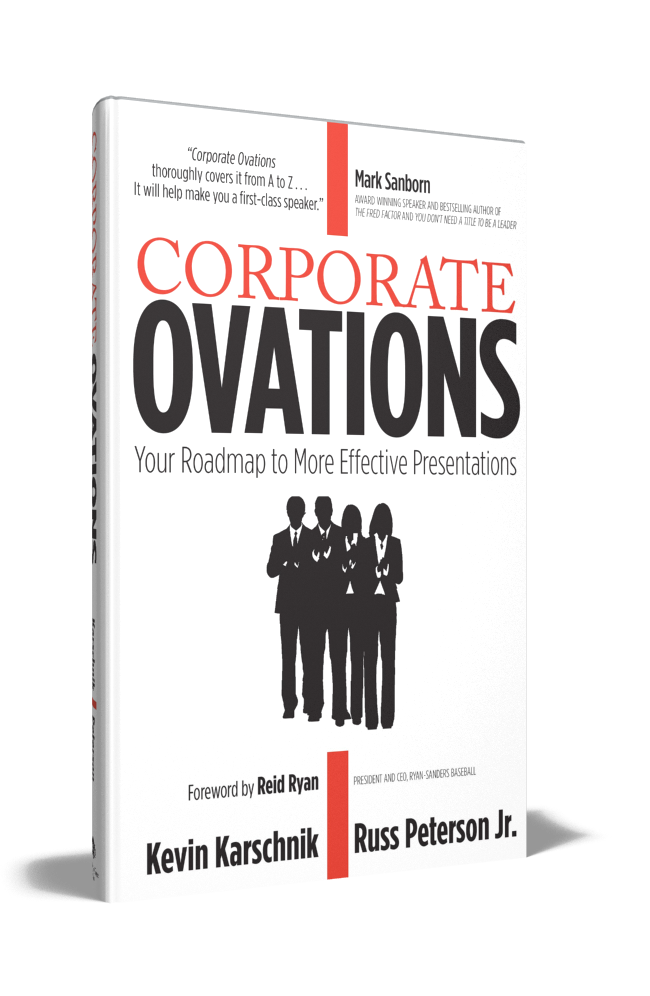“Well, uhh… that’s all I got folks. Thanks for coming… Oh WAIT! … Any questions? No? Okay then yeah, that’s all I got.” That’s word for word how he ended his presentation. While we’re probably all guilty of this at one time in our career, that doesn’t sound good. How do I know? Because I was just quoting myself! I’ve ended presentations like that before and I can honestly say, I’m not proud of it.

Since then, I’ve improved, but I still don’t consider myself the expert. When I finally heard myself ending presentations with “That’s all” or “Are there any questions?” I soon realized I needed to have a more effective way to end my presentations. Kevin Karschnik and I would love to take credit for inventing the formula we’ve documented, but in reality, we didn’t invent it. We discovered it.
By studying all kinds of speakers we discovered patterns with the speakers whom audiences enjoyed the most. We found these patterns in all types of effective speakers. Some were keynote speakers, some were delivering TED Talks, others were neighbors, one was a pastor, and some were sales and management colleagues. Whether these speakers knew they were doing it or not, we spotted a pattern. The pattern included 3 elements and sometimes (if needed) a 4th element.
How You Finish Matters
How you end your presentation can be one of the most remembered parts of your presentation. It just might determine whether or not your audience takes action too.
1. Summarize Your Message
This is a great way to conclude the body of your message and signal your audience you’re moving into your final remarks. Don’t make your summary long and detailed. They’ve already heard all your content once, they don’t need to hear it again! Be brief, but give them a content wrap up.
“Today I shared 3 methods for overcoming objections from your customers.”
“As we can all see, proper security includes physical assets, digital assets and predictable processes.”
2. Give Them an Emotional Reason to Change
Reminding them of the importance of your message can be done with a simple illustration or a short story. These types of examples work great to help the audience relate to the information in an emotional way. Before you think this isn’t appropriate for business presentations, read the examples below.
“What if you could retrieve your forecast numbers without having to spend hours inputting each opportunity in a spreadsheet?”
“Imagine a visitor is able to get into a secure area and gain access to our intellectual property. Then, when the investigation takes place they find out it’s because you badged into the building and let this person walk in the door behind you.”
3. Tell Them Their Next Step
Engaged audiences are ready to move, so make sure you give them their next step! When the audience is done hearing your message, what are they supposed to do next? What is the very next thing they should do? I’ve seen several amazing speakers summarize their key points and give an amazing emotional connection to the audience and then just leave them. The audience is amped up and ready to move and the speaker gave them no direction on their very next step. Tell them what to do next.
“So the next time you badge into the building, check your surroundings. Be bold when you remind the person behind you to badge in also.”
4. Remind Them Why it’s Important
A reminder of the expected benefit of the action or the avoidable cost of the inaction can give the audience the final motivation they need to take the next step you’re proposing. This part of the close can be easily written if you just put it after you give them their next step and then say these words, “if you do that…” When you fill in the blank after this phrase you’re giving them a reason to take the next step.
“… if you do that, you’ll not only be protecting the assets of this organization, but the future for all of us.”
How you close is important. Don’t let your audience down when we’re all counting on you!
Time for me to close…
Russ
Let’s connect…
iSpeak teaches workshops on Professional Selling to help sales leaders gather the most important data and then use that information to create the right message. Are your sales presentations closing eyelids or deals?
Russ Peterson Jr. is the co-founder and Managing Director of iSpeak, Inc. – An award-winning professional development training company. Russ is a speaker, international trainer, and published author on Professional Sales Communication and Business Communication. He delivers workshops, keynotes, and personal communication coaching services to business professionals in the US and around the world. His leadership blog assists leaders in giving voice to their vision. You can connect with Russ directly through Twitter, Facebook and LinkedIn.



Please note: I reserve the right to delete comments that are offensive or off-topic.